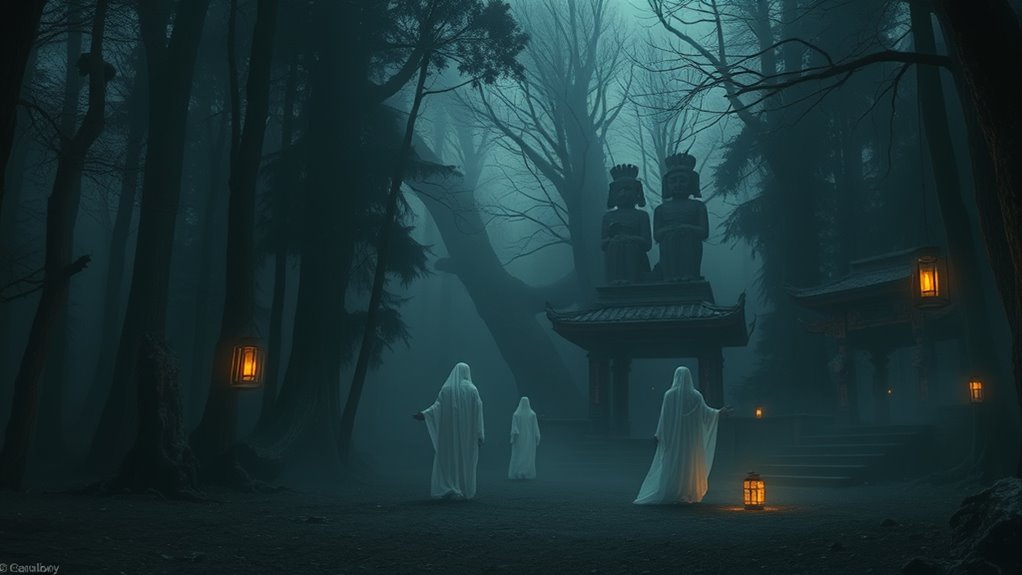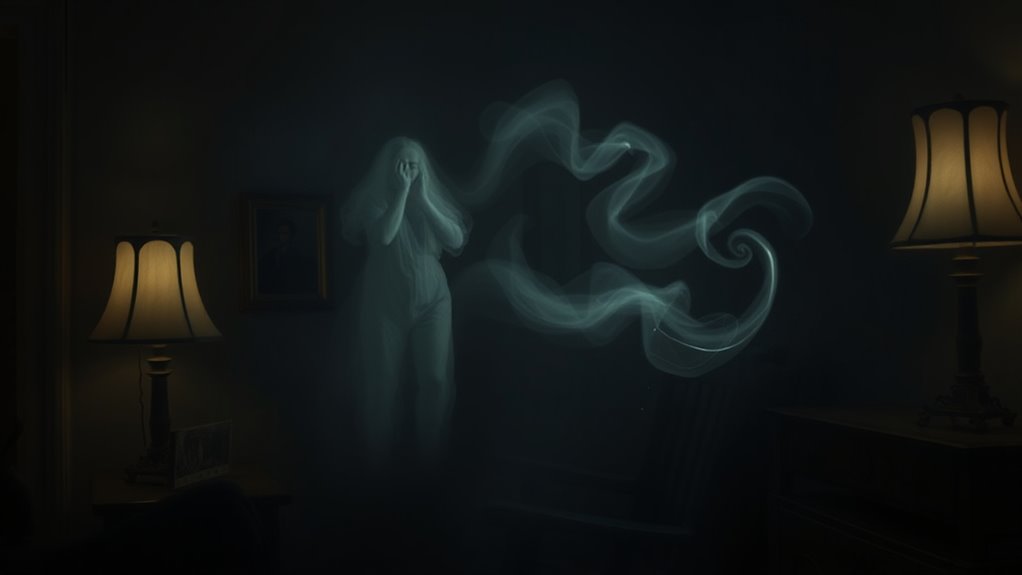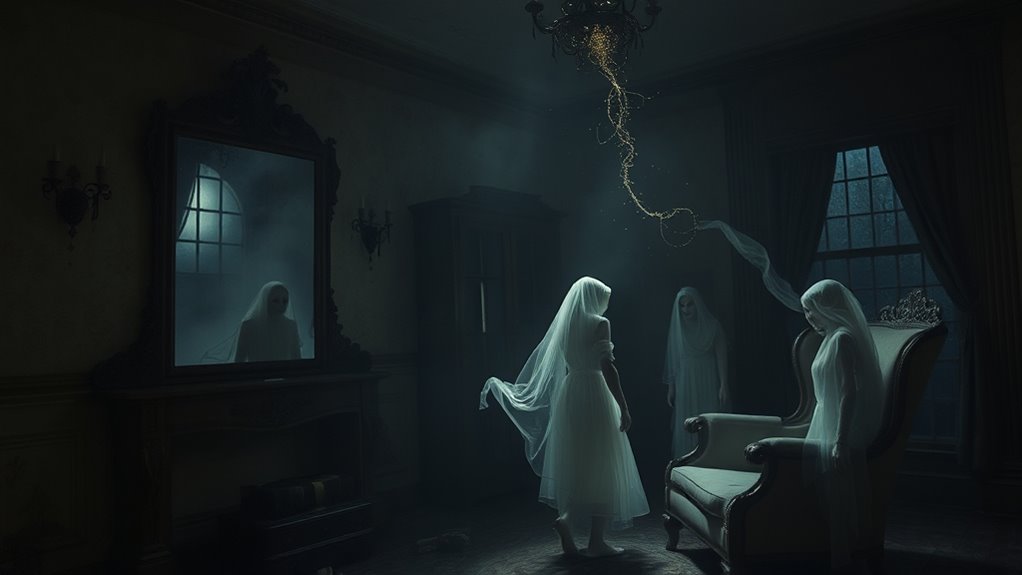Ghosts often stay behind because of unresolved issues, emotional attachments, or cultural beliefs assigning purpose to their presence. They might linger to complete unfinished business, protect loved ones, or due to environmental triggers like noises or cold spots. Psychological factors like hallucinations or stress can also create hauntings, while some spirits serve a higher purpose, such as guiding or safeguarding. To understand more about why spirits stay, you’ll explore how cultural views, emotion, and environment intertwine.
Key Takeaways
- Spirits often haunt due to unresolved emotional issues or unfinished business that keeps them tethered to the physical world.
- Cultural beliefs and rituals influence perceptions, viewing spirits as protectors, warning signs, or ancestors watching over.
- Environmental factors like residual energy, electromagnetic fields, or sensory triggers can activate spirits’ presence.
- Psychological factors such as stress, sleep paralysis, or hallucinations may cause perceived ghostly encounters.
- Some spirits stay behind to serve a higher purpose, protecting loved ones or maintaining spiritual harmony.
Cultural and Religious Interpretations of Haunting

Cultural and religious beliefs shape how you understand and interpret hauntings. In many traditions, spirits are seen as part of ongoing spiritual journeys or unresolved issues. Cultural rituals often involve ceremonies to communicate with or appease these spirits, ensuring they find peace. Religious beliefs influence whether hauntings are viewed as punishments, warnings, or acts of divine intervention. For example, some cultures see ghosts as ancestors watching over their descendants, requiring specific rituals to honor them. Others believe spirits linger due to unfinished business or moral debts. These interpretations guide how communities respond to hauntings, shaping their practices and attitudes. The role of spiritual connection in these beliefs emphasizes the importance of maintaining harmony with the spiritual world. Additionally, the cultural significance of rituals plays a crucial role in how communities engage with spirits and interpret their presence. Recognizing the variety of cultural perspectives on spirits can help foster understanding and respect for different traditions. The acknowledgment of cultural intelligence can facilitate better intercultural understanding of these beliefs. Ultimately, your cultural and religious background deeply influences whether you see spirits as malevolent entities or as misunderstood ancestors seeking connection.
Psychological Explanations for Apparitions

Many experiences attributed to ghosts can be explained through psychological processes occurring within the mind. Sleep paralysis, for example, can cause vivid hallucinations where you might see or feel a presence, tricking your brain into perceiving a ghostly figure. Hallucination triggers like stress, exhaustion, or certain medications can also produce similar visions. Your mind often interprets these sensations as supernatural, especially when you’re vulnerable or frightened. Recognizing these triggers helps you understand that what you perceive isn’t always paranormal but a natural response of your brain. Additionally, understanding how AI in Education is advancing can shed light on how our perceptions and expectations influence what we believe to be real or supernatural. Our brain’s perception and interpretation play a crucial role in shaping these experiences, influencing whether we interpret ambiguous stimuli as ghostly encounters.
Unfinished Business and Emotional Attachments

Unfinished business and emotional attachments often explain why certain spirits seem to linger. When a person leaves unresolved issues or strong feelings behind, they develop spiritual attachments that keep them connected to specific haunted locations. These spirits may be unable to move on because they feel unfinished, regretful, or tied to loved ones. They might haunt homes, cemeteries, or other places tied to their life stories. Recognizing these attachments can help explain why some locations feel so charged or emotionally intense. Emotional ties are common reasons include:
- Desire to complete unresolved tasks
- Fear of leaving loved ones behind
- Guilt or regret over past actions
Understanding these emotional ties helps demystify why spirits stay behind, often rooted in the depth of their unresolved feelings. Additionally, the history of pinball machines reveals how cultural shifts and societal attitudes towards entertainment and morality have influenced perceptions of spirits and hauntings over time, reflecting broader societal cultural influences on spiritual beliefs. Moreover, exploring spiritual attachments can offer insights into the ways unresolved emotional issues continue to affect both the living and the spirits.
Environmental and Physical Factors Influencing Spirits

Environmental and physical factors can considerably influence whether spirits choose to linger or move on. Residual energy from past events creates environmental triggers that can keep spirits tethered to a location. These triggers, like loud noises, specific scents, or sudden shadows, reactivate residual energy and reinforce their presence. The atmosphere’s emotional intensity can also intensify these effects, making it harder for spirits to find peace. To illustrate, consider the following:
| Trigger Type | Emotional Impact | Example |
|---|---|---|
| Residual Energy | Keeps spirits tethered | Old battlefields |
| Environmental Cues | Reignites memories | Flickering lights |
| Physical Factors | Amplifies sensations | Cold spots or drafts |
You can see how environment influences spirits’ decisions to stay or depart. Additionally, energy patterns in a location can either facilitate or hinder spirits’ movement, depending on their nature and strength. These energy disruptions can create conditions that trap spirits, preventing them from reaching peace. For example, electromagnetic fields may interfere with spirits’ communication or movement. Furthermore, certain environmental factors such as electromagnetic fields may also influence spirits’ presence and activity. A deeper understanding of environmental influences can shed light on why some spirits remain rooted in specific places.
The Possibility of Spirits Remaining for a Higher Purpose

Have you ever wondered if spirits stay behind not out of mere attachment or unrest, but to fulfill a higher purpose? Some believe spirits act as guardians, guiding loved ones or protecting sacred places. Others suggest they remain to balance cosmic energies, ensuring harmony between worlds. These spirits might serve as *spirit guardians*, assisting souls still on their journey or maintaining spiritual order. Their presence could be driven by a desire to help, heal, or complete unfinished tasks aligned with a divine or cosmic plan. This perspective shifts the idea of haunting from negative to purposeful, implying spirits stay behind for reasons beyond personal attachment. Additionally, some theories propose that spirits may be connected to traditional Italian cuisine, as certain foods and rituals are believed to help guide spirits or honor their memory. Ultimately, it invites you to contemplate that spirits may be part of a larger, meaningful cosmic role.
Frequently Asked Questions
Can Spirits Be Intentionally Summoned or Controlled?
You might wonder if spirits can be intentionally summoned or controlled. Through summoning rituals, some believe you can call spirits, but successful spirit manipulation depends on your skills and intent. Be cautious, as attempting to control spirits can be unpredictable and risky. While some claim to summon spirits at will, others warn that these practices can invite unintended consequences or negative energies. Always approach such endeavors with respect and caution.
Are Certain Locations More Prone to Hauntings Than Others?
Like a magnet attracts metal, certain places draw spirits more than others. Historical sites and abandoned buildings often hold echoes of the past, making them prone to hauntings. These locations symbolize memories left behind, where energy lingers. You might find yourself more likely to encounter spirits in such settings, as they serve as reminders of histories and stories that refuse to fade, keeping the connection alive between worlds.
How Do Different Cultures Interpret the Presence of Spirits?
You’ll notice that different cultures interpret spirits through unique cultural symbolism and ritual practices. In some societies, spirits are seen as ancestors offering guidance, while others view them as protectors or warnings. Rituals like offerings or ceremonies help communicate with these spirits, showing respect and seeking their favor. These diverse beliefs shape how communities understand and interact with spirits, reflecting their values and spiritual worldview.
Is There Scientific Evidence Supporting the Existence of Ghosts?
You wonder if there’s scientific proof for ghosts. Paranormal research explores this by studying unusual phenomena, but no conclusive evidence exists yet. Ghost detection methods often include electronic voice phenomena and infrared cameras, yet results remain inconclusive. While many believe in spirits, scientific communities require measurable data. Until proven, the existence of ghosts stays in the domain of mysteries and personal experiences rather than confirmed science.
Can Spirits Evolve or Move on to the Afterlife?
Imagine a shimmering shadow lingering in a quiet room, caught between worlds. You wonder if spirits can evolve or move on, yet often, unresolved trauma causes spirit attachment. These lingering energies cling to places or people, unable to find peace. While some believe spirits progress after death, many remain trapped by unfinished business, holding onto the past. Your understanding grows as you consider how emotional wounds may hinder spirits from crossing over.
Conclusion
So, when you wonder why spirits stick around, remember it’s like they’re holding onto a thread in the fabric of life. Whether it’s cultural beliefs, emotional ties, or environmental clues, spirits linger for reasons beyond our understanding. Maybe they’re waiting for closure or simply part of a story unfinished. Whatever the cause, their presence reminds us that some mysteries are like shadows—always lingering just beyond the light, whispering that there’s more to the story than meets the eye.









